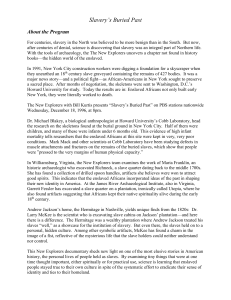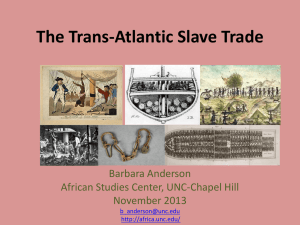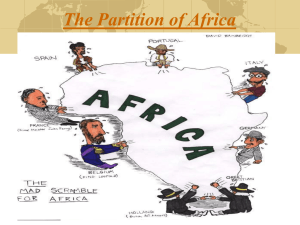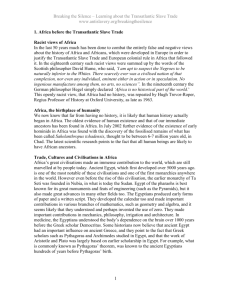African Crops and Slave Cuisine (Word)
advertisement
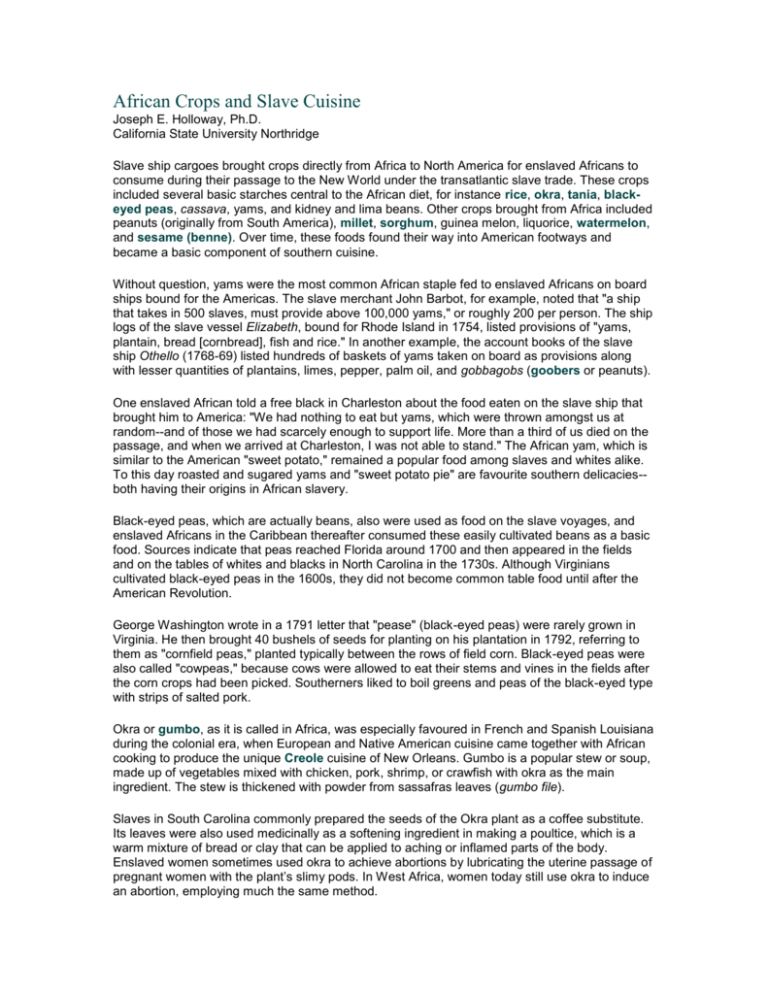
African Crops and Slave Cuisine Joseph E. Holloway, Ph.D. California State University Northridge Slave ship cargoes brought crops directly from Africa to North America for enslaved Africans to consume during their passage to the New World under the transatlantic slave trade. These crops included several basic starches central to the African diet, for instance rice, okra, tania, blackeyed peas, cassava, yams, and kidney and lima beans. Other crops brought from Africa included peanuts (originally from South America), millet, sorghum, guinea melon, liquorice, watermelon, and sesame (benne). Over time, these foods found their way into American footways and became a basic component of southern cuisine. Without question, yams were the most common African staple fed to enslaved Africans on board ships bound for the Americas. The slave merchant John Barbot, for example, noted that "a ship that takes in 500 slaves, must provide above 100,000 yams," or roughly 200 per person. The ship logs of the slave vessel Elizabeth, bound for Rhode Island in 1754, listed provisions of "yams, plantain, bread [cornbread], fish and rice." In another example, the account books of the slave ship Othello (1768-69) listed hundreds of baskets of yams taken on board as provisions along with lesser quantities of plantains, limes, pepper, palm oil, and gobbagobs (goobers or peanuts). One enslaved African told a free black in Charleston about the food eaten on the slave ship that brought him to America: "We had nothing to eat but yams, which were thrown amongst us at random--and of those we had scarcely enough to support life. More than a third of us died on the passage, and when we arrived at Charleston, I was not able to stand." The African yam, which is similar to the American "sweet potato," remained a popular food among slaves and whites alike. To this day roasted and sugared yams and "sweet potato pie" are favourite southern delicacies-both having their origins in African slavery. Black-eyed peas, which are actually beans, also were used as food on the slave voyages, and enslaved Africans in the Caribbean thereafter consumed these easily cultivated beans as a basic food. Sources indicate that peas reached Florida around 1700 and then appeared in the fields and on the tables of whites and blacks in North Carolina in the 1730s. Although Virginians cultivated black-eyed peas in the 1600s, they did not become common table food until after the American Revolution. George Washington wrote in a 1791 letter that "pease" (black-eyed peas) were rarely grown in Virginia. He then brought 40 bushels of seeds for planting on his plantation in 1792, referring to them as "cornfield peas," planted typically between the rows of field corn. Black-eyed peas were also called "cowpeas," because cows were allowed to eat their stems and vines in the fields after the corn crops had been picked. Southerners liked to boil greens and peas of the black-eyed type with strips of salted pork. Okra or gumbo, as it is called in Africa, was especially favoured in French and Spanish Louisiana during the colonial era, when European and Native American cuisine came together with African cooking to produce the unique Creole cuisine of New Orleans. Gumbo is a popular stew or soup, made up of vegetables mixed with chicken, pork, shrimp, or crawfish with okra as the main ingredient. The stew is thickened with powder from sassafras leaves (gumbo file). Slaves in South Carolina commonly prepared the seeds of the Okra plant as a coffee substitute. Its leaves were also used medicinally as a softening ingredient in making a poultice, which is a warm mixture of bread or clay that can be applied to aching or inflamed parts of the body. Enslaved women sometimes used okra to achieve abortions by lubricating the uterine passage of pregnant women with the plant’s slimy pods. In West Africa, women today still use okra to induce an abortion, employing much the same method. Peanuts came to North America by way of Africa, having been transplanted there from the Portuguese and Spanish colonies in South America. The peanut is known by several names including groundnut, earthnut and ground peas. Two other words of African origin for peanuts are pinder and goober. Both Thomas Jefferson and George Washington called peanuts "peendar" and "Pindars" (1794, 1798), while the word goober was used principally in the 19th century. Union soldiers fighting on southern soil during the Civil War found southern peanuts both tasty and filling. The Civil War song "Eating Goober Peas" was a popular ditty sung by Union soldiers, and, when the song was published its lyrics and music, were attributed to the fictitious team of "A. Pindar" and P. Nutt." Enslaved Africans used the peanut to make peanut pie and peanut soup. Often times, it was boiled in salt and spices, and consumed as a soggy, strong tasting but good source of nutrition. Community "peanut boilings" were common neighbourhood events, and the practice of feeding pigs massive amounts of peanuts to fatten them for show or sale was known as "hogging off." Sesame, a tropical Asian plant bearing small flat seeds, first arrived in South Carolina from Africa in the 1730s. The seeds could be eaten as food or pressed for oil. An American merchant introduced sesame oil to England in 1730, and the product became a profitable New World substitute for the imported olive oil used for cooking. In order not to import olive oil from the Middle East, Britain encouraged production of sesame oils by offering bounties for cultivation of the sesame plant. By 1733, a book on gardening published in London, noted the usefulness of sesame oil as "sallet-oil." Thomas Jefferson reported in the 1770s that African Americans ate sesame seeds in a variety of ways: raw, in salads, toasted or boiled in soup, baked in breads, boiled with greens, and cooked as broth. Today, sesame is consumed primarily as bread topping. The successful cultivation of rice in the United States is thought by some historians to have occurred in the South Carolina Sea Islands when an enslaved African woman taught her white owner how to grow the crop. The first rice seeds used in rice farming may have been imported directly from the Island of Madagascar in 1685, and historians generally believe that enslaved Africans familiar with growing rice in West Africa supplied the expertise for its production in North America. No matter who first introduced African rice to the Americas, by 1750 some of the largest slave owners in the South cultivated rice in the coastal regions of the Carolinas in ways similar to how it had been grown by Africans for hundreds of years. African cooks in the "Big House" and the slave quarters introduced their native African crops and foods to white planters and farmers, thus linking African and European culinary cultures. African cooks, for example, may have introduced deep fat frying, a cooking technique common in Africa as a means of preserving chicken and beef--although Europeans traditionally fried beef and pork as well. Watermelons, known affectionately as "August hams," were especially popular in Africa and remained a common food among southern blacks and whites in the summer months. Enslaved Africans sometimes planted watermelons in the cotton or cornfields and enjoyed them during breaks from their work on hot summer days. The African custom of roasting pigs, beef, chickens, and lambs on an open spit with a pan of sauce on the side for dipping the meat may have been the origins of the southern "barbecue." The word possibly stems from the Haitian Creole word "barbacoa," meaning a stack of burning sticks. Another important African dish popular in the slave South was fufu, a type of pancake prepared by boiling water and stirring in flour and other ingredients. In South Carolina, this dish is still called "turn meal and flour." Africans prepare fufu by mixing palm oil while turning in flour. From this fufu mixture, slaves made hoecakes in the fields by using the blades of their hoes as frying pans. These hoecakes evolved into pancakes and hot water cornbread. Cornbread, prepared by enslaved Africans, was similar to African millet bread, and it, too, was a food slave traders used to feed enslaved Africans on the slave ships. For instance, a June 20, 1796, journal entry of the slave ship Mary notes a "woman cleaning rice and grinding corn for corn cakes." As early as 1739, naturalist Mark Catesby noted that slaves made a mush from the corn meal called pone bread. He also noticed that slaves boiled the hauled and dried kernels of Indian corn (hominy), and ground them into a meal known as grits, a food similar to the African dish called Eba. Today, southerners eat grits as a starch to accompany their eggs and bacon instead of potatoes for breakfast. Over time, these African foods, grains, and spices helped fashion a form of southern cuisine that was regionally distinct. Much of the foods consumed by slaves comprised the cast-offs of meals they prepared for whites or whatever else they could grow or catch on their own to supplement the meagre corn and pork rations their owners doled out to them. The enslaved took these discarded animal parts (such as hog maw or the pig’s stomach, hog jowl, pig's feet, and ham hocks) and added African and Native American cooking techniques and home-grown vegetables and spices to create tasty dishes that have survived today as something called "Soul Food." As Africans, the enslaved used all parts of plants and animals, and they adapted their traditional diets to their slave experiences. The result was a special blending of Africa and America culinary styles producing a truly international, Creole cuisine, both vibrant and immensely rich in character. Glossary of Slave Foods Cala: Sweetened rice cake, African in origin, served with morning café au lait, formerly sold by black women in the French Quarter of New Orleans. In Georgia, this sweetened rice cake was called saraka. A women born in slavery in the 1930s recalls her mother making the cakes: "Yesium. I membuh how she made it. She wash rice, ann po off all duh watah. She let wet rice sit all night, and put in mawtuhm an beat it tuh paste wid wooden pastle. She add honey, sometime shuguh, add it in floot cake wid uh kams. Saraka, she call um." Calalu: Thick soup or stew similar to gumbo. Ferdinand Ortiz traced calalu to African coilu, which is a Mandingo name for a plant resembling spinach. In Pointe Coupee, Louisiana, it is a rich soup or stew in which one or more kinds of calalu leaves are the chief ingredients. Calalu is also the name given to several plants having edible leaves, eaten as greens and in soup, or used medicinally. Coffee: Word derived from Kaffa, region in Ethiopia. Cowpeas: Vigna unguiculata, black-eyed peas. Used in the southern U.S. by both blacks and whites. Traveled from Africa to North America in holds of slave ships as food for the cargoes. Cush, chushie: Sweet, fried cornmeal cake that first appeared in American English in 1770. Gullah kush or kushkush. Related to Hausa via Arabic kusha. Fufu: Called "turn meal and flour" in South Carolina. A mixture of cornmeal and flour is poured into a pot of boiling water. From this fufu mixture, enslaved Africans made "hot cakes" in the fields, which were sometimes called ashcakes or hoecakes. These evolved into "pancakes" and "hotwater cornbread." Fufu is a common food throughout Africa and the New World; it consists of yams, plantains, and cassava roots (manioc, tapioca) cut into pieces and boiled together; maize or Indian corn beaten into one mass and eaten with pepper, boiled in a pot with okra. A substantial dish of fufu is composed of eddoes, ochas, and mashed plantains made savory with rich crabs and pungent with cayenne pepper. Goober: A Bantu word for peanut. Another word for peanut is pinder from the Congo word mpinda. The first known records of the word are in Jamaica in 1707, and in South Carolina in 1848. Pinder Town is the name of a place in South Carolina. Grits: Enslaved Africans took hominy (the hauled dried kernels of Indian corn) and made grits by grinding the corn hauls and cooking them; grits is similar to eb, which is eaten in Africa. Guinea Corn: Guinea Corn, also called sorghum and millet (Sorghum vulgave), is an indigenous African crop transported to North America by Africans. Gumbo: This word is similar to the Tshiluba word kingombo and the Umbundu word ochingombo. It is a soup made of okra pods, shrimp, and powdered sassafras leaves. It was known to most southerners by the 1780s. Gunger Cake: Gingerbread, which is a dark molasses cake flavored with the powdered root of the ginger plant, is thought to have originated in the Congo and been carried to North America by enslaved Africans. Hop'n johns: Traditional West African dish of black-eyed peas and rice cooked together. It is common in black southern cuisine. Jambalaya: Bantu tshimbolebole, dish of tender, cooked corn. African-influenced dish similar to gumbo, particular to New Orleans. Africans brought to Louisiana from the Kongo. Jollof Rice: Style of cooking red rice brought to the American South by the Mande of West Africa. Juba: Traditional slave food. Refers to the food that enslaved Africans working in the plantation house collected from the "massa's" leftovers. Such leftovers were called juba, jibba, or jiba. On Saturday or Sunday, the leftovers were thrown together; no one could distinguish the meat from the bread and vegetables. This juba was placed in a huge pot, and those working in the 'Big House" shared it with those working in the fields. Maluvu: Tshiluba maluvu, palm wine. Produced throughout Africa from sap or juice collected from palm trees. African Americans continued to make it in Savannah, Georgia; in South Carolina, the palmetto tree is the source of this potent brew. In some cases, African Americans extracted material from the center the palmetto tree, called palm cabbage or palmetto cabbage, and cooked or fermented it for wine. Millet Bread: The seeds of various grasses made into bread were used as food on the slave ships that carried enslaved Africans to the Americas. Okra: Abelmoschus esculentus, also called guibo and guimyombo, originated in what geobotanists call the Abyssinian (Ethiopian) center of human food zones. It is still cultivated in present-day Ethiopia on the plateau portions of Eritrea, and in parts of the Sudan. It also became the essential ingredient of Louisiana gumbo. Peanut Oil: First introduced by enslaved Africans in the American South, especially in deep-fat frying, a cooking style that originated in western and central Africa. Pone Bread: Enslaved Africans made mush from cornmeal and called it pone bread, a mush cake similar to mush patties baked in African for centuries. Kola: Cola acuminate and Cola nitida. Trees were native to western Sudan, and their fruit, the Kola nut, became the principal ingredient used in making modern cola drinks. During the slave trade, kola nuts were given enslaved Africans to suppress their hunger and thirst. They were used also as a medicine of sorts. A transatlantic slaver wrote: "The seed, brought in a Guinean ship from that country, is called 'bichy' by the Colomanty and is eaten and used for pains in the belly." Rice: Oryza sativa and Oryza glaberrimi, were indigenous varieties of rice imported in 1685 from the island of Madagascar to South Carolina. Some historians contend that enslaved Africans first showed white Americans how to cultivate rice. By 1740, rice had become a major staple in the South Carolina farming and slave-based economy. Sesame: Sesamum indicum, or sesame, also known as benne seed in South Carolina were brought as seeds by West Africans to South Carolina. Slaves raised large crops of sesame, being fond of the plant's nutritious seeds for making soups and puddings. They also used sesame oil for cooking and lighting lamps within private estates as well as on the public roads. Tania: Colocasia esculenta, coco yam; eddo in West Africa; Tanya in West Indies. Appears indigenous to Central Africa with two known varieties: "Old coco yam" (Colocaccia antiquorum) probably originated in the Congo basin, with its earliest citation being made by the Portuguese in the 15th century; "Coco yam Tania" (Xanthosomaa sagitifolium) was a popular root plant in Sea Islands of Gerogia and South Carolina. Watermelon: Citrullus vulgaris, spread from Sudan to Egypt during the second millennium B.C.E. Now, it is distributed throughout the world. The transatlantic slave trade served as a major vehicle in transporting watermelon to the New World, where it remained a favorite among blacks and whites alike. Enslaved field hands often planted watermelon in the fields so they could enjoy them in July and August, the two hottest months of the year, while they hoed and picked cotton.

